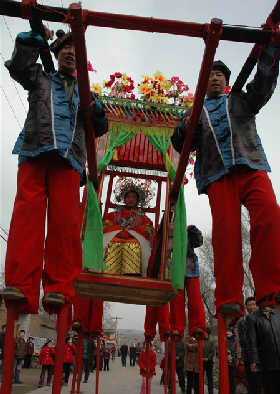Burning Sedan on Stilts
Updated: 2007-08-21 14:58

Wanshan Village is located in Qingyang City of northwest China's Henan Province. As a strategically important location with roads extending in all directions, the village was developed as a military outpost in ancient China. The old village consists of five communities named by their locations, among which the Southern Community is the cradle of the so-called "burning sedan on stilts."
The practice is said to have originated during the Tang and Song dynasties (dates) when locals celebrated the Spring Festival with performances involving dancing on stilts and carrying bridal sedan-chairs.
The custom developed further during the Ming Dynasty (date) when Zhu Zaiyu, an imperial prince, abandoned his title and retired near Wanshan Village. He found that the folk artists there ranked at the bottom of the social structure, and feeling sorry for them, helped create a new art which combined stilts dancing with carrying the bridal sedan-chair.
The new art substituted night performances for daytime shows, with candles and a Chinese dragon's head spouting fire being attached to the bridal sedan-chair, to signify wishes for a happy and prosperous life among the local people during the coming year.
The performances typically were held between New Year's Day and the Lantern Festival on the 15th day of the Chinese New Year, with troupes of more than 100 artists marching through the streets on stilts. The performances made Wanshan Village a regional attraction.
The practice has dipped in recent decades, with older artists passing away. However, state policies aimed at preserving non-material heritage have helped to resurrect the art and in June of last year, villagers began learning the art again from senior practitioners. Two month later, they had revived performances and took part this year in the Henan Non-Material Heritage Festival during the spring festival.
Walking on Stilts
Cai Gaoqiao, or walking on stilts, is a celebratory folk dance. Performers strap on two long stilts, making them easily visible to audience members, and perform on a "moving stage," by freely walking.
The practice can be traced back to the Spring and Autumn Period (770-476 B.C.) and has been called a variety of names throughout its history. During the Song Dynasty (420-479 A.D.) it was known as "Taqiao;" it was called "Gaoqiao" during the Qing Dynasty. In Beijing, the performances are called "Gaoqiao meeting" and "Za Gaojiao" in the Huanghe River valley region.
Performers dress as characters from popular stories and perform to the music of the suona horn, a woodwind instrument. They act out scenes from operas like "Nao Tiangong" ("Havoc in heavenly palace"), and "Shui Man Jinshan" ("The flood of Jinshan"). Performers wear stilts of different heights according to their roles. For example, in the opera "Shui Man Jinshan," the performer playing Fa Hai wears stilts 4-feet-tall, while the actor playing the Buddhist novice wears 2.5-feet-tall stilts.
Carrying Sedan Chairs
Tai Huajiao, or carrying sedan chairs, became a popular folk dance during the middle period of the Republic of China (1912-1949). The performer who sits in the sedan chair is usually dressed as an ugly county magistrate with a black gauze cap or as a beautiful woman played by a man in ancient costume, with a handkerchief in hand. Four sedan-chair bearers are also played by "choujue," or comic roles in traditional opera. The sedan chair used is a wooden one without a bottom, decorated by the red and green silk cloth. The performer sits in the chair and dances to the folk music.